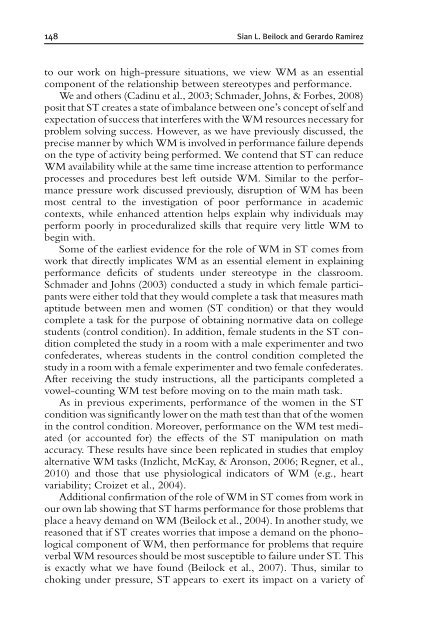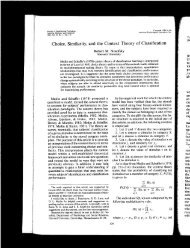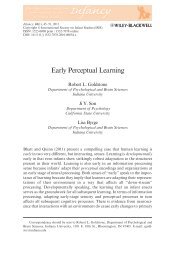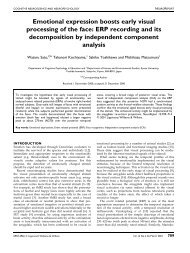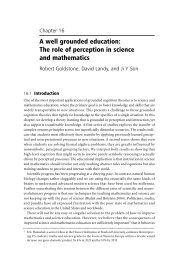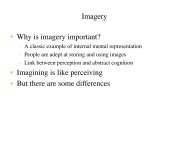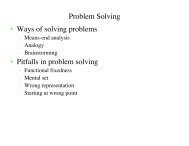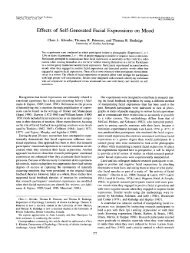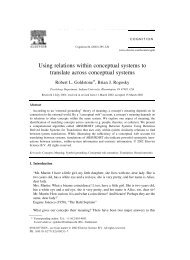the psychology of learning and motivation - Percepts and Concepts ...
the psychology of learning and motivation - Percepts and Concepts ...
the psychology of learning and motivation - Percepts and Concepts ...
Create successful ePaper yourself
Turn your PDF publications into a flip-book with our unique Google optimized e-Paper software.
148 Sian L. Beilock <strong>and</strong> Gerardo Ramirezto our work on high-pressure situations, we view WM as an essentialcomponent <strong>of</strong> <strong>the</strong> relationship between stereotypes <strong>and</strong> performance.We <strong>and</strong> o<strong>the</strong>rs (Cadinu et al., 2003; Schmader, Johns, & Forbes, 2008)posit that ST creates a state <strong>of</strong> imbalance between one’s concept <strong>of</strong> self <strong>and</strong>expectation <strong>of</strong> success that interferes with <strong>the</strong> WM resources necessary forproblem solving success. However, as we have previously discussed, <strong>the</strong>precise manner by which WM is involved in performance failure dependson <strong>the</strong> type <strong>of</strong> activity being performed. We contend that ST can reduceWM availability while at <strong>the</strong> same time increase attention to performanceprocesses <strong>and</strong> procedures best left outside WM. Similar to <strong>the</strong> performancepressure work discussed previously, disruption <strong>of</strong> WM has beenmost central to <strong>the</strong> investigation <strong>of</strong> poor performance in academiccontexts, while enhanced attention helps explain why individuals mayperform poorly in proceduralized skills that require very little WM tobegin with.Some <strong>of</strong> <strong>the</strong> earliest evidence for <strong>the</strong> role <strong>of</strong> WM in ST comes fromwork that directly implicates WM as an essential element in explainingperformance deficits <strong>of</strong> students under stereotype in <strong>the</strong> classroom.Schmader <strong>and</strong> Johns (2003) conducted a study in which female participantswere ei<strong>the</strong>r told that <strong>the</strong>y would complete a task that measures mathaptitude between men <strong>and</strong> women (ST condition) or that <strong>the</strong>y wouldcomplete a task for <strong>the</strong> purpose <strong>of</strong> obtaining normative data on collegestudents (control condition). In addition, female students in <strong>the</strong> ST conditioncompleted <strong>the</strong> study in a room with a male experimenter <strong>and</strong> twoconfederates, whereas students in <strong>the</strong> control condition completed <strong>the</strong>study in a room with a female experimenter <strong>and</strong> two female confederates.After receiving <strong>the</strong> study instructions, all <strong>the</strong> participants completed avowel-counting WM test before moving on to <strong>the</strong> main math task.As in previous experiments, performance <strong>of</strong> <strong>the</strong> women in <strong>the</strong> STcondition was significantly lower on <strong>the</strong> math test than that <strong>of</strong> <strong>the</strong> womenin <strong>the</strong> control condition. Moreover, performance on <strong>the</strong> WM test mediated(or accounted for) <strong>the</strong> effects <strong>of</strong> <strong>the</strong> ST manipulation on mathaccuracy. These results have since been replicated in studies that employalternative WM tasks (Inzlicht, McKay, & Aronson, 2006; Regner, et al.,2010) <strong>and</strong> those that use physiological indicators <strong>of</strong> WM (e.g., heartvariability; Croizet et al., 2004).Additional confirmation <strong>of</strong> <strong>the</strong> role <strong>of</strong> WM in ST comes from work inour own lab showing that ST harms performance for those problems thatplace a heavy dem<strong>and</strong> on WM (Beilock et al., 2004). In ano<strong>the</strong>r study, wereasoned that if ST creates worries that impose a dem<strong>and</strong> on <strong>the</strong> phonologicalcomponent <strong>of</strong> WM, <strong>the</strong>n performance for problems that requireverbal WM resources should be most susceptible to failure under ST. Thisis exactly what we have found (Beilock et al., 2007). Thus, similar tochoking under pressure, ST appears to exert its impact on a variety <strong>of</strong>


